- HOME
- VISIT
- ABOUT
- TOURS
- VISITOR FAQs
- LOCAL RESOURCES
- FAST FACTS
- MOAH HISTORY
- WILLIAMS HOUSE
- VICTORY GARDEN
- BOARD AND STAFF
- EXHIBITS
- CURRENT EXHIBIT
- PERMANENT EXHIBITS
- FUTURE EXHIBITS
- PAST EXHIBITS
- ARCHIVED EXHIBITS
- COLLECTION
- COLLECTION HISTORY
- DONATE TO THE COLLECTION
- SEARCH COLLECTION
- PROGRAMS & EVENTS
- CALENDAR
- ADULT PROGRAMS
- CHILDREN'S PROGRAMS
- ANNUAL EVENTS
- PAST EVENTS
- SPECIAL EVENTS
- GET INVOLVED
- MEMBERSHIP
- VOLUNTEER
- GIFT OPPORTUNITIES
- STAY CONNECTED
- EMAIL SIGNUP
- NEWSLETTERS
- PRESS
- Membership Response
The Industrial Age: 1650 AD to 1900 AD
The first photograph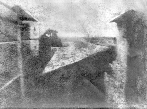 "View from the Window at Le Gras", made in 1826 by Joseph Nicephore Niepce, is believed
to be the oldest surviving photograph. The photo of farm buildings and a field was made
as a positive image on a metal plate (thought to be pewter) coated with bitumen, a
somewhat light sensitive petroleum derivative. Exposure time was eight hours. The image
may have been developed by washing the exposed plate with a mixture of lavender oil and
white petroleum that dissolved the unexposed bitumen.
"View from the Window at Le Gras", made in 1826 by Joseph Nicephore Niepce, is believed
to be the oldest surviving photograph. The photo of farm buildings and a field was made
as a positive image on a metal plate (thought to be pewter) coated with bitumen, a
somewhat light sensitive petroleum derivative. Exposure time was eight hours. The image
may have been developed by washing the exposed plate with a mixture of lavender oil and
white petroleum that dissolved the unexposed bitumen.
Early developments in photography
Daguerreotype
Introduced in 1839 in France by Louis J. M. Daguerre, the first photographic print process was the daguerreotype. It was made on a silver-coated copper plate which was, for all practical purposes, a mirror. The sensitizing agent was iodine, the developing agent was mercury. Once exposed in a camera and developed, the plate became a photograph on a mirror. Daguerreotypes were rarely used after 1860.
If you move your head while observing a daguerreotype, you will see the photo turn from positive to negative and back again.
Ambrotype
Ambrotypes are negative photos on glass plates. When black paper is placed behind the glass, the image appears to be a positive print. The sensitizing agent was silver nitrate, the developing agent was pyrogallic acid.
Invented in England by Frederick Scott, the ambrotype was introduced in America in 1854 and last made in 1865.
Tintype
The tintype was made the same way as the ambrotype, except a thin iron plate coated with Japan varnish substituted for the glass plate. Hamilton Smith, the inventor of the tintype, introduced the process in 1856. Its lower cost and easier to use process made it quickly popular, and it continued in use until about 1930.
Early tintypes (also called melainotypes or ferrotypes) were supplied in cases, as were the ambrotypes and Daguerreotypes of the period. During the Civil War years, photographers began placing them on thin card stock or in small albums. Tintypes also were made in full plate sizes or double plate sizes for framing and display on walls. Quality varied considerably: Some tintypes were works of art. Others looked terrible, even when new. There is no tin in a tintype: "Tintype" is believed to be a derogatory reference to the poorly made prints, tin being considered a cheap metal.
Typewriters
Information has been recorded by stylus, pen, brush and pencil, written to whatever media were most available and appropriate. Media included stone, shell, clay, metal, papyrus, cloth, paper. Until recently, good penmanship was considered an important indicator of literacy. The typewriter initiated changes in that perception.
Attempts at workable typewriting machines first appeared in the early 1800s, but enjoyed little commercial success until the Remington Arms Company (USA) marketed in 1874 a design bought from Sholes. The typewriter wrought a major change in the business environment: No longer was it necessary to write a fine copperplate hand to have a career in business: Documents could be produced more quickly and legibly by the machine. The typewriter vastly expanded the clerical labor pool.
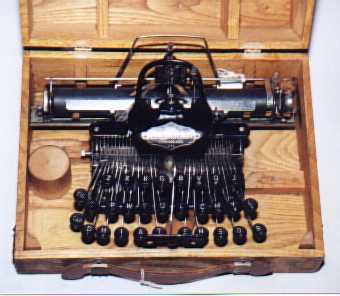 Some typewriters were specialized. Portables, such as this 1905 Blickendorfer (left), appeared
relatively early. Note the non-QWERTY key arrangement and the ergonomically correct
keyboard layout.
Some typewriters were specialized. Portables, such as this 1905 Blickendorfer (left), appeared
relatively early. Note the non-QWERTY key arrangement and the ergonomically correct
keyboard layout.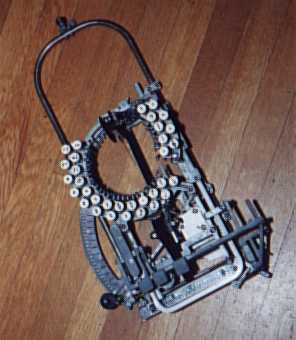 Other specialized typewriters, such as the Keaton music notation unit (right),
occupied niche market segments.
Other specialized typewriters, such as the Keaton music notation unit (right),
occupied niche market segments.
The typewriter also introduced the concept of the keyboard as a means of text input to information processing systems, a notion adopted in future generations of inventions such as the teletypewriter, the typesetting machine, the keypunch and, of course, the computer and its word processing cousin.
Sound storage
When Thomas Edison invented the phonograph in 1877, he created the first technology for recording and reproducing sounds as perceived by people. Edison used a vibrating stylus connected to a sound collecting horn to record sound vibrations as a vertical pattern of waves on the surface of a rotating tinfoil cylinder. The tinfoil was soon replaced by wax, and the cylinders, which were hard to produce economically, evolved into the familiar, and less expensive, phonograph disks (1877), much to Edison's discontent. Disk recordings use a horizontal stylus motion, rather than the vertical motion employed by Edison.
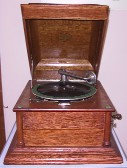 Early phonographs, such as the disk player on the right, were entirely mechanical, using
spring driven motors (note winding crank on right side)to rotate the cylinder or disk and
relying upon the acoustical energy of the recorded sound wave to drive the recording
stylus. They were suprisingly loud, although of limited fidelity. Electrical phonographs
waited on the development of the vacuum tube and the nationwide deployment of electric
power lines.
Early phonographs, such as the disk player on the right, were entirely mechanical, using
spring driven motors (note winding crank on right side)to rotate the cylinder or disk and
relying upon the acoustical energy of the recorded sound wave to drive the recording
stylus. They were suprisingly loud, although of limited fidelity. Electrical phonographs
waited on the development of the vacuum tube and the nationwide deployment of electric
power lines.
The phonograph had an economic life of under 100 years. By the 1970s, it had been largely displaced by magnetic tape.
Punched cards: From the Jacquard loom to the Florida Vote
Joseph-Marie Jacquard's card-programmed loom (1805) was the first machine to make use of punched cards as an information storage device. The stored data was used to control woven fabric patterns. The idea of the punched card as a data input device was adopted by Charles Babbage for his designs of mechanical computers.
The next major advance was the punched card driven tabulator of Herman Hollerith used in the 1890 census. His card was sized to fit currency tabulating machines used in the banks of the period (7 3/8" x 3 1/4"), and determined the size of the standard punched card used since. Hollerith's Tabulating Machine Company, formed in 1896, was absorbed by the Computing-Tabulating Recording Company in 1911.
Keyboard operated card punch machines appeared in 1901. Electrically operated keypunch machines were introduced in 1923 by IBM.
The Computing-Tabulating-Recording Company, a precursor to IBM, was formed in 1911. It was renamed International Business Machines in 1924.
Other formats were used besides the 80 column, 13 row rectangular hole Hollerith card format. The Remington Rand Univac used cards with a 90 column, round hole format, and IBM itself introduced a 96 column card in the 1970s for its System/3 and ATM machines. If you drove on the New Jersey Turnpike in the 1960/1970s, you were handed a 90 column card when you entered the Turnpike.
In 1952, IBM was producing 16 billion punched cards per year, but the use of punched cards dropped rapidly after the introduction of magnetic tape drives and disk drives for storage in the 1950s and 1960s. IBM probably regretted the passing of the punched card: At one time, 25% of IBM profits were reported to be generated by card sales. But environmentalists didn't mourn its passing, as it consumed an incredible number of trees!
Punched cards are still with us, in active use as storage media for voting machines. Michigan was the first state to use punched cards to record votes. Perhaps Florida will be the last. Will you punch chad this year?
Punched Cards (1900 - 1980)
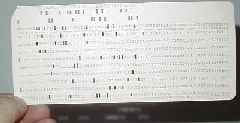 Punch cards used a variety of formats and sizes developed by various
manufacturers in addressing their data storage needs throughout time.
European systems, represented by the smaller Powers-Samas card shown here, tended to
be more compact than American cards. Another factor which varied considerably was
the number of holes in the card-while the IBM 80-column card, roughly the size of an
1890 dollar bill, become the standard, 90 and 96-column cards were also popular
(with Remington-Rand and IBM System/3 respectively). Cards were also combined with
microfiche as a means of maintaining a catalog by computer and frequently had logotypes
or other distinctive backgrounds representing the institutions (for example,
universities) at which they were used.
Punch cards used a variety of formats and sizes developed by various
manufacturers in addressing their data storage needs throughout time.
European systems, represented by the smaller Powers-Samas card shown here, tended to
be more compact than American cards. Another factor which varied considerably was
the number of holes in the card-while the IBM 80-column card, roughly the size of an
1890 dollar bill, become the standard, 90 and 96-column cards were also popular
(with Remington-Rand and IBM System/3 respectively). Cards were also combined with
microfiche as a means of maintaining a catalog by computer and frequently had logotypes
or other distinctive backgrounds representing the institutions (for example,
universities) at which they were used.
Jacquard Loom
 Joseph-Maire Jacquard was a weaver in the French town of Lyons who, in 1805 patented a
weaving machine controlled by a series of punched cards. The pattern of holes in the
card controlled the warp and weft of fabric (typically silk) on the loom. His simple
and elegant system of cards was widely copied and adapted to a variety of uses such as
controlling player pianos and, eventually, the storing of information for computers.
The Jacquard loom is the ancestor of today's computer controlled machine tools and
other automated production equipment.
Joseph-Maire Jacquard was a weaver in the French town of Lyons who, in 1805 patented a
weaving machine controlled by a series of punched cards. The pattern of holes in the
card controlled the warp and weft of fabric (typically silk) on the loom. His simple
and elegant system of cards was widely copied and adapted to a variety of uses such as
controlling player pianos and, eventually, the storing of information for computers.
The Jacquard loom is the ancestor of today's computer controlled machine tools and
other automated production equipment.
Jacquard Loom Punchcards and Sample Weaving (ca. 1985)
This 'ribbon' of punch cards controls the expression of threads in a loom. The patterns of holes shown here produced the "World of Trout" weaving shown here.
This model, constructed in 1985, is a replica of the machine used in early programmed loom designs. Note that the punch cards controlling the loom's operation are fastened together to keep them in order, an effective method of defeating certain types of program "bugs".
Hollerith Census Machine
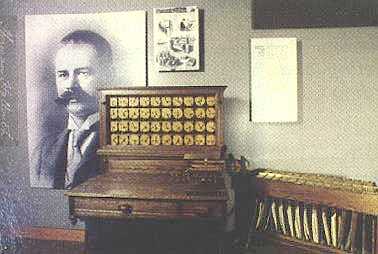 This is a model of the Hollerith Census Machine of 1890. The Census Machine
read special punch cards, which contained information whose encoding was based on the
position of holes in the card. Since the 1880 census was still being tabulated in the
late 1880s, the Census Machine was a response to the urgent need for automation. The
unit on the left is the accumulator; the unit on the right is a card sorter.
This is a model of the Hollerith Census Machine of 1890. The Census Machine
read special punch cards, which contained information whose encoding was based on the
position of holes in the card. Since the 1880 census was still being tabulated in the
late 1880s, the Census Machine was a response to the urgent need for automation. The
unit on the left is the accumulator; the unit on the right is a card sorter.
Hermann Hollerith, the machine's designer (depicted upon wall behind model), went on to great success, his company merging with two others and eventually, in 1924, becoming the International Business Machines Corporation (IBM).
Model by Roberto Guatelli, circa 1985
IBM Model 016 keypunch (1929)
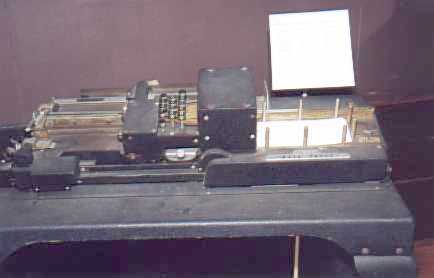 This early IBM keypunch, the Model 016, was introduced in 1929. Its automatic feed and
ejection features aided key punching and reduced operator fatigue. These mechanisms
ejected one card and fed another in 0.65 seconds. The feed mechanism was developed by
F. Lee and G. F. Daly; the ejector mechanism was developed by F.W. Richter of IBM's
German operation. The Model 016 also had a duplicating feature that meant that any
information common to one card could be duplicated on another accurately and rapidly.
It was a long-lived product, not being withdrawn from IBM's product line until the 1950s.
This early IBM keypunch, the Model 016, was introduced in 1929. Its automatic feed and
ejection features aided key punching and reduced operator fatigue. These mechanisms
ejected one card and fed another in 0.65 seconds. The feed mechanism was developed by
F. Lee and G. F. Daly; the ejector mechanism was developed by F.W. Richter of IBM's
German operation. The Model 016 also had a duplicating feature that meant that any
information common to one card could be duplicated on another accurately and rapidly.
It was a long-lived product, not being withdrawn from IBM's product line until the 1950s.
Punched Paper Tape
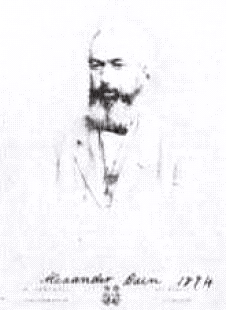 In 1846, Scottish inventor and clockmaker Alexander Bain demonstrated the use of punched
paper tape to send telegraph messages. His creation was a follow-on to earlier work
using pens to create marks on paper tape as a telegraph message was received.
(This notion was ultimately expanded upon to create the facsimile machine)
In 1846, Scottish inventor and clockmaker Alexander Bain demonstrated the use of punched
paper tape to send telegraph messages. His creation was a follow-on to earlier work
using pens to create marks on paper tape as a telegraph message was received.
(This notion was ultimately expanded upon to create the facsimile machine)
 Commercial development was furthered by Sir Charles Wheatstone, who developed a two
track format that stored data in Morse code for automatic telegraph transmission in 1857.
One of the tracks represented dots, the other the dashes that make up a character in
telegraphic code. A message could be punched onto the tape by clerical staff for
transmission at a later time without the need for a skilled telegraphist. The
Wheatstone transmitter could send 100 characters a minute.
Commercial development was furthered by Sir Charles Wheatstone, who developed a two
track format that stored data in Morse code for automatic telegraph transmission in 1857.
One of the tracks represented dots, the other the dashes that make up a character in
telegraphic code. A message could be punched onto the tape by clerical staff for
transmission at a later time without the need for a skilled telegraphist. The
Wheatstone transmitter could send 100 characters a minute.
The limited amount of data that could be stored on a punched card inspired the use of punched paper tape to store data. The punched rolls used in player pianos could be considered an early form of punched tape, but this was a very specialized application.
 The typical format used parallel tracks to store the data bits, while a character was
formed by punching holes crosswise across the tape at a particular location. 5, 6, 7,
and 8 track tapes were used in various applications. The 5 track format was developed
by Baudot, whose name is honored in the term "Baud", which defines a unit of
transmitted information.
The typical format used parallel tracks to store the data bits, while a character was
formed by punching holes crosswise across the tape at a particular location. 5, 6, 7,
and 8 track tapes were used in various applications. The 5 track format was developed
by Baudot, whose name is honored in the term "Baud", which defines a unit of
transmitted information.
Konrad Zuse, a German inventor who developed one of the earliest digital computer designs in the 1930s, used punched 35 millimeter film recycled from local movie theatres instead of paper for data storage tapes. Later prototype computers, such as the EDSAC and the Colossus, also used punched paper tape to store programs and data. Because paper was subject to tearing, plastic substrates such as metallized mylar were also used in later designs.
In the 1960s, punched tape was popular as storage for small minicomputers, such as the DEC PDP-8, HP 2116 and Varian Data Machines 620i. The original paper tape readers used springy wires to read the holes in the tape, but were limited to speeds of 10 to 50 characters per second. The tape was driven through the reader by a sprocket wheel that engaged a track of holes punched into the tape specifically for the purpose of controlling tape movement. Sprocket holes were positioned off center so that the operator could correctly orient the tape in the reader. Later readers used optical detection to read the holes, and could read hundreds of characters per second. These readers used reel to reel transports and capstan mechanisms to control tape motion, much as modern tape recorders do today.
Punched tape was in use well into the 1970s for storage of computer programs and data and for transmission by teletype, but it was rapidly supplanted by magnetic tape thereafter. It was also widely used for typesetting and control of machine tools and other automated manufacturing equipment.
Play that paper tape
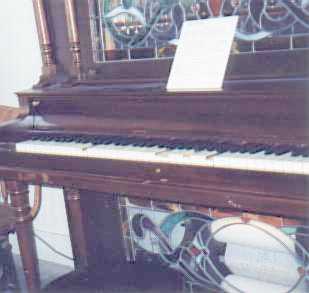 The music that this player piano produces is recorded as holes in the wide role of
punched paper tape you can see at the base of the piano. Each hole represents a
depression of a piano key. Modern player pianos use a floppy disk to store their
data, with information stored as magnetic patterns rather than as punched holes.
The music that this player piano produces is recorded as holes in the wide role of
punched paper tape you can see at the base of the piano. Each hole represents a
depression of a piano key. Modern player pianos use a floppy disk to store their
data, with information stored as magnetic patterns rather than as punched holes.
ASR-33 Teletype (1962)
In November 1931, the Bell System inaugurated the teletypewriter exchange service, often called the TWX (pronounced "twicks") system. It provided a complete communications system for the written word, including teletypewriters, transmission channels and switchboards. The Model ASR-33 Teletype shown here was introduced in 1962 and was quickly adopted as the interface of choice for early minicomputers and, as inexpensive microprocessors arrived on the scene in the mid-1970s, for microcomputers as well.
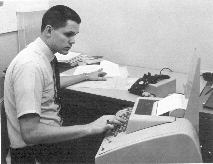 The Model 33 came in two versions: the ASR-33 (which stood for 'Automatic Send and
Receive') had an integrated paper tape reader and puncher for off-line data preparation
and storage. A second version, the KSR (Keyboard Send and Receive) version had a
keyboard only. The ASR version was the most popular as it allowed 'sharing' of
computer programs on paper tape. Bill Gates' first commercial product, MITS Altair
BASIC, was delivered to users on punched paper tape produced by Teletype.
The Model 33 came in two versions: the ASR-33 (which stood for 'Automatic Send and
Receive') had an integrated paper tape reader and puncher for off-line data preparation
and storage. A second version, the KSR (Keyboard Send and Receive) version had a
keyboard only. The ASR version was the most popular as it allowed 'sharing' of
computer programs on paper tape. Bill Gates' first commercial product, MITS Altair
BASIC, was delivered to users on punched paper tape produced by Teletype.
Magnetic recording: The beginning
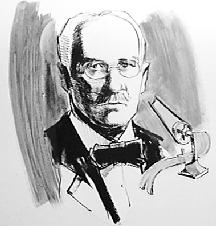 In 1878, American mechanical engineer Oberlin Smith conceived the idea of recording
electrical signals produced by the telephone on a steel wire after an 1877 visit to
the laboratory of Thomas A. Edison. He spent 10 months developing the concept of a
reel-to-reel wire recording system, filed a "patent caveat", but never did file a
formal patent, deciding in 1888 not to pursue his idea. However, he made it publicly
available by publishing his thoughts concerning magnetic recording in "Electrical World".
This journal may have inspired Valdemar Poulsen, who turned Smith's concept into a
practical invention in 1898. Smith held 70 patents, inventing or improving
die presses, can-making devices, looms, locks, a malted milk mixer, a garage door opener,
and a device to automatically extract eggs from boiling water at a pre-set cooking time.
In 1878, American mechanical engineer Oberlin Smith conceived the idea of recording
electrical signals produced by the telephone on a steel wire after an 1877 visit to
the laboratory of Thomas A. Edison. He spent 10 months developing the concept of a
reel-to-reel wire recording system, filed a "patent caveat", but never did file a
formal patent, deciding in 1888 not to pursue his idea. However, he made it publicly
available by publishing his thoughts concerning magnetic recording in "Electrical World".
This journal may have inspired Valdemar Poulsen, who turned Smith's concept into a
practical invention in 1898. Smith held 70 patents, inventing or improving
die presses, can-making devices, looms, locks, a malted milk mixer, a garage door opener,
and a device to automatically extract eggs from boiling water at a pre-set cooking time.

|
This page
last updated: May 6, 2010 Original content: Copyright © 2000, 2001, 2002-2010 Museum of American Heritage Trademarks are the property of their owners |
 |
Join today! Membership dues help sustain MOAH. For more information and to download a Membership Form
LEARN MORE HERE
For questions and comments
Contact Us.
Mailing Address
PO Box 1731, Palo Alto, CA 94302
351 Homer Avenue
Palo Alto, California
p. 650.321.1004
e.



